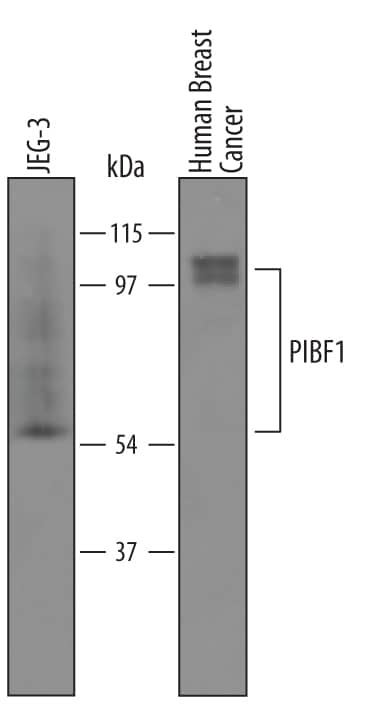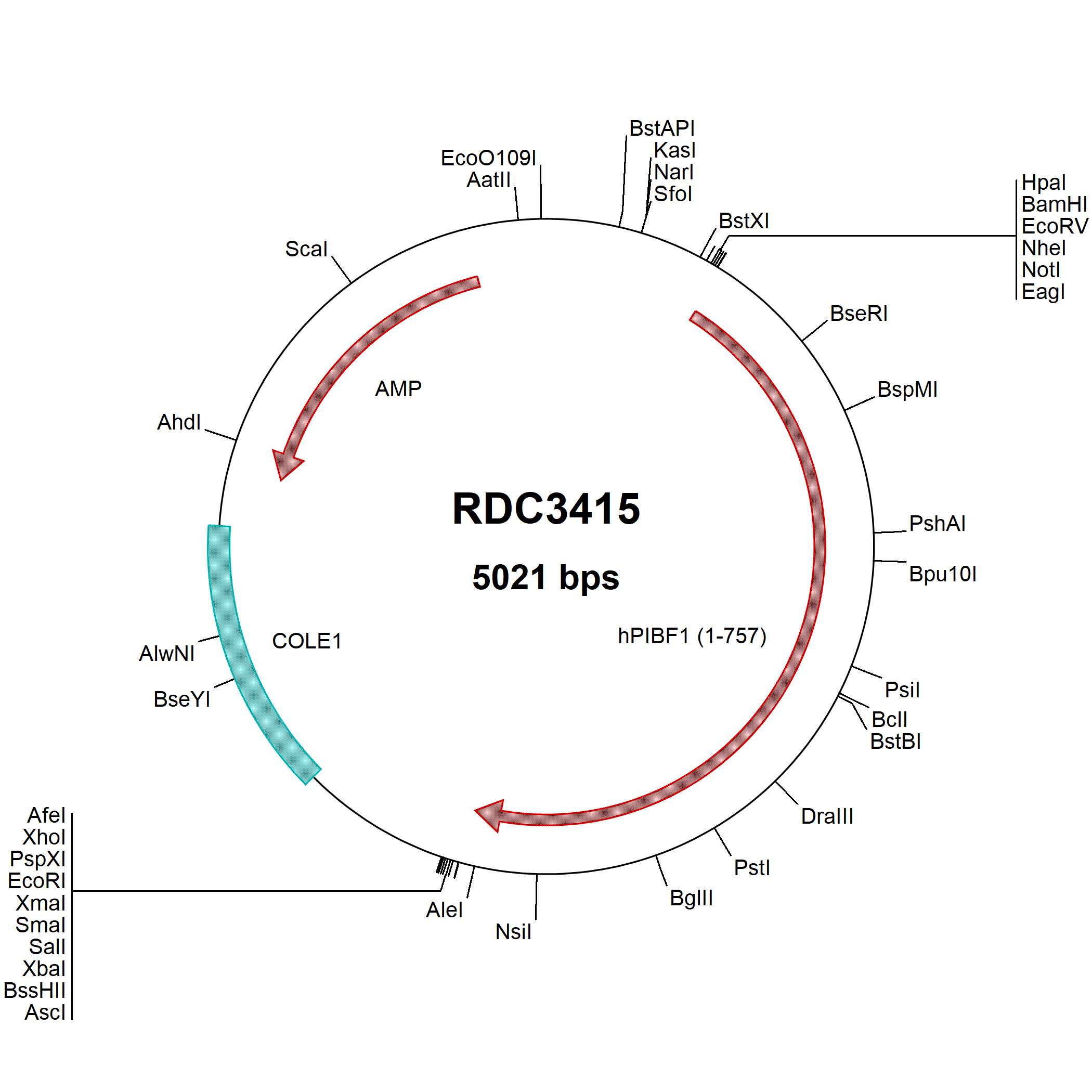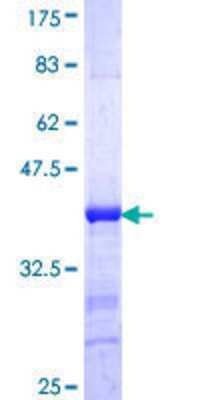PIBF1 Products
PIBF-1 (Progesterone induced blocking factor 1) is a 90-92 kDa progesterone-inducible molecule initially isolated from the lymphocytes of pregnant women. It is produced by lymphocytes plus villous trophoblast cells, and modulates the activity of cytotoxic NK cells. Human PIBF-1 is 757 amino acids (aa) in length. It contains a possible signal sequence (aa 1-26), two Leu-zippers (aa 311-323 and 643-664), two NLSs (aa 282-285 and 567-573), a bZIP sequence (aa 574-614), and an ER retention motif (aa 752-757). PIBF-1 is found in the nucleus, cytoplasm, and circulation, the result of multiple splice variants. SDS-page shows 90 kDa, 80-83 kDa, 48-52 kDa, 34-35 kDa, and 10-12 kDa isoforms. The 90 kDa form is nuclear and full-length, while the 34-35 kDa form is secreted and likely represents aa 1-223 spliced to aa 683-757. There is a 50-55 kDa form that is apparently intracellular, possibly bioactive and likely represents the N-terminus of the molecule. Over aa 19-419, human PIBF-1 shares 88% aa identity with mouse PIBF-1.
42 results for "PIBF1" in Products
42 results for "PIBF1" in Products
PIBF1 Products
PIBF-1 (Progesterone induced blocking factor 1) is a 90-92 kDa progesterone-inducible molecule initially isolated from the lymphocytes of pregnant women. It is produced by lymphocytes plus villous trophoblast cells, and modulates the activity of cytotoxic NK cells. Human PIBF-1 is 757 amino acids (aa) in length. It contains a possible signal sequence (aa 1-26), two Leu-zippers (aa 311-323 and 643-664), two NLSs (aa 282-285 and 567-573), a bZIP sequence (aa 574-614), and an ER retention motif (aa 752-757). PIBF-1 is found in the nucleus, cytoplasm, and circulation, the result of multiple splice variants. SDS-page shows 90 kDa, 80-83 kDa, 48-52 kDa, 34-35 kDa, and 10-12 kDa isoforms. The 90 kDa form is nuclear and full-length, while the 34-35 kDa form is secreted and likely represents aa 1-223 spliced to aa 683-757. There is a 50-55 kDa form that is apparently intracellular, possibly bioactive and likely represents the N-terminus of the molecule. Over aa 19-419, human PIBF-1 shares 88% aa identity with mouse PIBF-1.
| Reactivity: | Human |
| Details: | Sheep IgG Polyclonal |
| Applications: | WB, IHC |
| Reactivity: | Human |
| Details: | Rabbit IgG Polyclonal |
| Applications: | WB, ICC/IF |
| Reactivity: | Human |
| Details: | Mouse IgG1 kappa Monoclonal Clone #7B7 |
| Applications: | IHC, WB, ELISA, ICC/IF |
| Applications: | WB, ELISA |
| Reactivity: | Human |
| Details: | Rabbit IgG Polyclonal |
| Applications: | WB, ICC/IF |
| Applications: | ELISA |
| Applications: | WB, ELISA, MA, AP |
| Applications: | WB, ELISA, MA, AP |
| Reactivity: | Human |
| Details: | Rabbit IgG Polyclonal |
| Applications: | WB, IP, ChIP |
| Reactivity: | Human |
| Details: | Mouse IgG2b Kappa Monoclonal Clone #7A3 |
| Applications: | WB, ELISA |
| Reactivity: | Human |
| Details: | Rabbit IgG Polyclonal |
| Applications: | WB, IP |
| Reactivity: | Human |
| Details: | Rabbit IgG Polyclonal |
| Applications: | IHC |
| Applications: | ELISA |
| Reactivity: | Human |
| Details: | Rabbit IgG Polyclonal |
| Applications: | WB, IP |
| Reactivity: | Human |
| Details: | Rabbit IgG Polyclonal |
| Applications: | WB, IP |
| Reactivity: | Human |
| Details: | Rabbit IgG Polyclonal |
| Applications: | WB, IP |
| Reactivity: | Human |
| Details: | Rabbit IgG Polyclonal |
| Applications: | WB, IP |
| Reactivity: | Human |
| Details: | Rabbit IgG Polyclonal |
| Applications: | WB, IP |
| Reactivity: | Human |
| Details: | Rabbit IgG Polyclonal |
| Applications: | WB, IP |
| Reactivity: | Human |
| Details: | Rabbit IgG Polyclonal |
| Applications: | WB, IP |
| Reactivity: | Human |
| Details: | Rabbit IgG Polyclonal |
| Applications: | WB, IP |
| Reactivity: | Human |
| Details: | Rabbit IgG Polyclonal |
| Applications: | WB, IP |
| Reactivity: | Human |
| Details: | Rabbit IgG Polyclonal |
| Applications: | WB, IP |
| Reactivity: | Human |
| Details: | Rabbit IgG Polyclonal |
| Applications: | WB, IP |



![Western Blot: PIBF1 Antibody [NBP2-19823] Western Blot: PIBF1 Antibody [NBP2-19823]](https://resources.bio-techne.com/images/products/PIBF1-Antibody-Western-Blot-NBP2-19823-img0001.jpg)
![Immunocytochemistry/ Immunofluorescence: PIBF1 Antibody (7B7) [H00010464-M02] Immunocytochemistry/ Immunofluorescence: PIBF1 Antibody (7B7) [H00010464-M02]](https://resources.bio-techne.com/images/products/PIBF1-Antibody-7B7-Immunocytochemistry-Immunofluorescence-H00010464-M02-img0004.jpg)

![Western Blot: PIBF1 Overexpression Lysate [NBL1-14389] Western Blot: PIBF1 Overexpression Lysate [NBL1-14389]](https://resources.bio-techne.com/images/products/PIBF1-Overexpression-Lysate-Adult-Normal-Western-Blot-NBL1-14389-img0002.jpg)
![Western Blot: PIBF1 Antibody [NBP2-56805] Western Blot: PIBF1 Antibody [NBP2-56805]](https://resources.bio-techne.com/images/products/PIBF1-Antibody-Western-Blot-NBP2-56805-img0002.jpg)
![ELISA: Human PIBF1 ELISA Kit (Colorimetric) [NBP2-68096] - Human PIBF1 ELISA Kit (Colorimetric)](https://resources.bio-techne.com/images/products/nbp2-68096_human-pibf1-elisa-kit-colorimetric-1322024168534.jpg)

![Western Blot: PIBF1 Antibody [NB100-58834] Western Blot: PIBF1 Antibody [NB100-58834]](https://resources.bio-techne.com/images/products/PIBF1-Antibody-Western-Blot-NB100-58834-img0002.jpg)
![Western Blot: PIBF1 Antibody (7A3) [H00010464-M01] Western Blot: PIBF1 Antibody (7A3) [H00010464-M01]](https://resources.bio-techne.com/images/products/PIBF1-Antibody-7A3-Western-Blot-H00010464-M01-img0001.jpg)
![Western Blot: PIBF1 Antibody [NB100-58835] Western Blot: PIBF1 Antibody [NB100-58835]](https://resources.bio-techne.com/images/products/PIBF1-Antibody-Western-Blot-NB100-58835-img0002.jpg)
![Immunohistochemistry: PIBF1 Antibody [NBP2-49474] Immunohistochemistry: PIBF1 Antibody [NBP2-49474]](https://resources.bio-techne.com/images/products/PIBF1-Antibody-Immunohistochemistry-NBP2-49474-img0001.jpg)
![ELISA: Mouse PIBF1 ELISA Kit (Colorimetric) [NBP2-68097] - Mouse PIBF1 ELISA Kit (Colorimetric)](https://resources.bio-techne.com/images/products/nbp2-68097_mouse-pibf1-elisa-kit-colorimetric-132202416201981.jpg)
